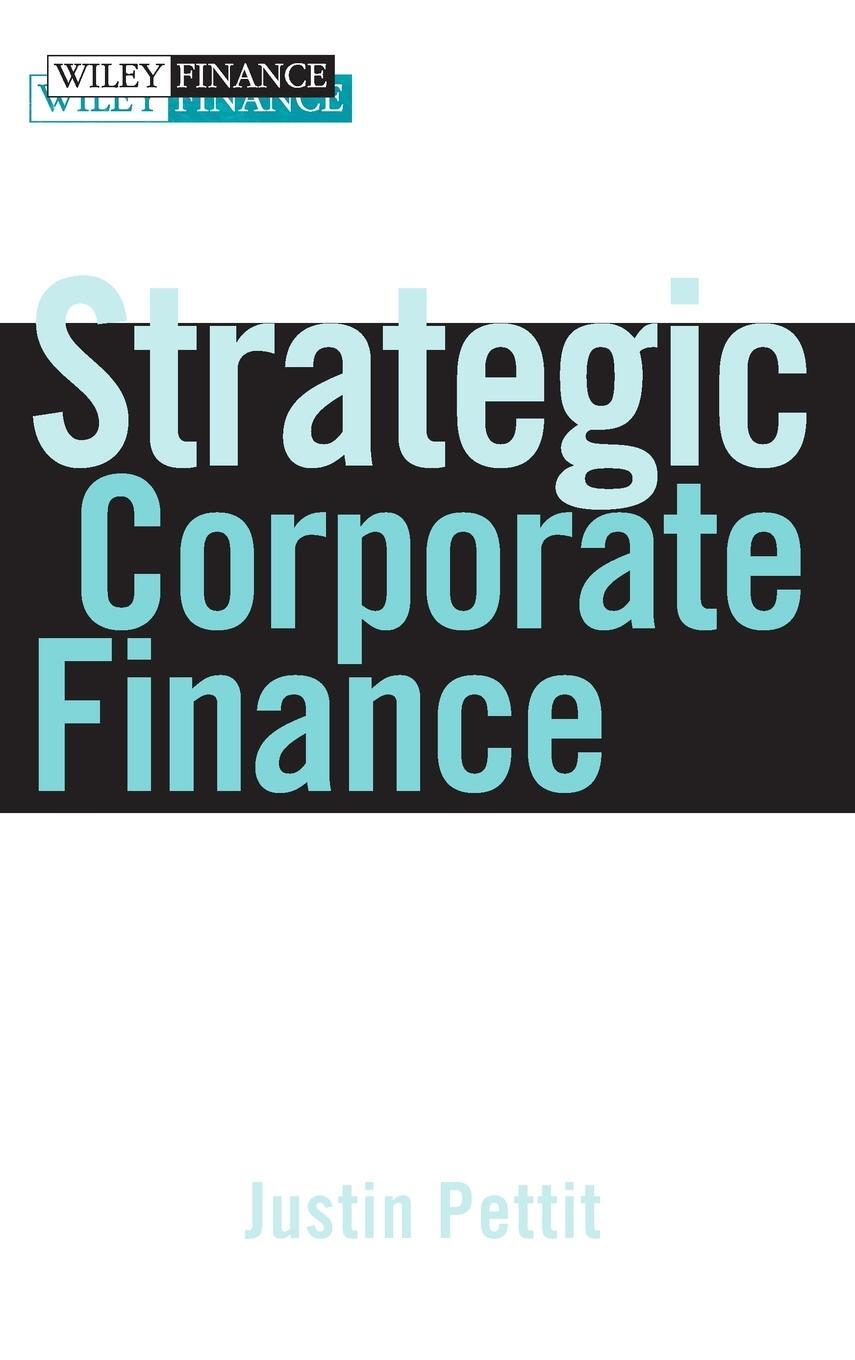Dekorationsartikel gehören nicht zum Leistungsumfang.
Sprache:
Englisch
91,00 €*
Versandkostenfrei per Post / DHL
Aktuell nicht verfügbar
Kategorien:
Beschreibung
Essential guidance for the corporate finance professional -- advisor, Board Director, CFO, Treasurer, business development executive, or M&A expert--to ask the right questions and make the critical decisions. Strategic Corporate Finance is a practical guide to the key issues, their context, and their solutions. From performance measurement and capital planning to risk management and capital structure, Strategic Corporate Finance, translates principles of corporate finance theory into practical methods for implementing them. Filled with in-depth insights, expert advice, and detailed case studies, Strategic Corporate Finance will prepare you for the issues involved in raising, allocating and managing capital, and its associated risks.
Justin Pettit (New York, NY) draws on his 15 years of senior advisory experience as an investment banker and management consultant. He advises corporate boards and executives on matters of capital structure, financial policy, valuation, and strategy. He also lectures on topics in advanced corporate finance to graduate and undergraduate students at universities in the New York area.
Justin Pettit (New York, NY) draws on his 15 years of senior advisory experience as an investment banker and management consultant. He advises corporate boards and executives on matters of capital structure, financial policy, valuation, and strategy. He also lectures on topics in advanced corporate finance to graduate and undergraduate students at universities in the New York area.
Essential guidance for the corporate finance professional -- advisor, Board Director, CFO, Treasurer, business development executive, or M&A expert--to ask the right questions and make the critical decisions. Strategic Corporate Finance is a practical guide to the key issues, their context, and their solutions. From performance measurement and capital planning to risk management and capital structure, Strategic Corporate Finance, translates principles of corporate finance theory into practical methods for implementing them. Filled with in-depth insights, expert advice, and detailed case studies, Strategic Corporate Finance will prepare you for the issues involved in raising, allocating and managing capital, and its associated risks.
Justin Pettit (New York, NY) draws on his 15 years of senior advisory experience as an investment banker and management consultant. He advises corporate boards and executives on matters of capital structure, financial policy, valuation, and strategy. He also lectures on topics in advanced corporate finance to graduate and undergraduate students at universities in the New York area.
Justin Pettit (New York, NY) draws on his 15 years of senior advisory experience as an investment banker and management consultant. He advises corporate boards and executives on matters of capital structure, financial policy, valuation, and strategy. He also lectures on topics in advanced corporate finance to graduate and undergraduate students at universities in the New York area.
Über den Autor
JUSTIN PETTIT draws on his fifteen years of senior advisory experience as an investment banker and management consultant. He advises corporate boards and executives on matters of capital structure, financial policy, valuation, and strategy. He also lectures on topics in advanced corporate finance to graduate and undergraduate students at universities in the New York area.
Inhaltsverzeichnis
Preface.
List of Figures.
List of Tables.
Acknowledgments.
About the Author.
PART ONE: Managing the Left-Hand Side of the Balance Sheet.
Chapter 1: The Cost Of Capital.
Calculation Pitfalls.
Market Risk Premium (MRP).
Toward a Better Beta.
The "Riskless Rate"
The Cost of Debt.
Global Capital Costs.
WACC and Hurdle Rates.
Chapter 2: Fix: Finding Your Sources of Value.
Why Shareowner Value?
Performance Measurement Pitfalls.
Measuring Economic Profit and Value.
Analyzing the Corporate Portfolio.
Incorporating the Cost of Capacity.
Value-Based Strategies and Tactics.
Managing for Value.
Balancing Performance with Value.
Chapter 3: Sell: Creating Value Through Divestiture.
Divestiture Creates Value.
Sources of Value: Motives for Divestiture.
Alternative Methods of Disposition.
What Works Best for Whom?
What Happens Longer Term?
Practical Impediments to Divestiture.
Financial Policy Considerations.
Tax Considerations and Structural Refinements.
Chapter 4: Grow: How To Make M&A Pay.
M&A Today.
Transactions that Create Value.
M&A Fact and Fallacy.
RX for the "Conglomerate Discount."
EVA and M&A.
How ''Serial Acquirers'' Create Value.
Financial Policy Considerations.
Financing Growth.
Chapter 5: Cash and The Optimal Capital Structure.
Trends and Implications.
How Much Is Too Much?
The Costs and Benefits of Excess Cash.
How the Market Views Excess Cash.
Optimal Capital Allocation.
PART TWO: Managing the Right-Hand Side of the Balance Sheet.
Chapter 6: An Executive's Guide to Credit Ratings.
Trends and Implications.
Empirical Evidence.
Limitations of Quantitative Credit Analysis.
What Metrics Matter Most?
Case Study: Treatment of Pension and Postretirement Liabilities.
Multivariate Credit Models.
Industry Considerations.
Case Study: Property and Casualty Insurance.
Application Issues.
How to Manage Your Agencies.
Case Study: Illustration of Secured and Unsecured Notching.
Chapter 7: Today's Optimal Capital Structure.
Value-Based Financial Policy.
Less Debt Is Now "Optimal."
Extend Duration When Rates Are Low.
Maintain Financial Liquidity to "Insure" Your Equity.
A New Perspective on Equity.
Case Study: Does Tech Need Debt?
Chapter 8: Dividends and Buybacks: Calibrating Your Shareholder Distributions.
The Cash Problem.
Dividends Are Back.
How Dividends and Buybacks Create Value.
Should You Increase Your Dividend?
How Large Should Your Buyback Program Be?
How to Execute Your Share Repurchase Program.
Chapter 9: The Stock Liquidity Handbook.
Measuring Stock Liquidity.
The "Liquidity Discount."
Implications of Stock Illiquidity.
Solutions to Illiquidity.
Stock Splits.
PART THREE: Managing the Enterprise.
Chapter 10: Strategic Risk Management: Where ERM Meets Optimal Capital Structure.
The Value of Risk Management.
Mapping and Modeling Risk.
Managing to a Benchmark.
External Considerations and Constraints.
ERM Case Study: Metallgesellschaft AG.
Capital Structure Solutions.
Chapter 11: Best Practices In Hedging.
Which "Exposure" to Hedge.
Hedge Horizon.
Hedge Ratio.
Options versus Forwards.
Accounting Considerations.
Implementation.
Chapter 12: ERM Case Study: Reengineering The Corporate Pension.
Why Now?
The Problems with Equity.
The Case for More Bonds.
Optimal Capital Structure Reprise.
Capital Markets Solutions.
The Boots Case.
Why It Still Hasn't Happened.
APPENDIX A: Resources.
Tools and Portals.
New Research and Literature Search.
Economic Research and Data.
News and Market Data.
Corporate Governance and Compensation.
Other Agencies.
Endnotes.
References.
Index.
List of Figures.
List of Tables.
Acknowledgments.
About the Author.
PART ONE: Managing the Left-Hand Side of the Balance Sheet.
Chapter 1: The Cost Of Capital.
Calculation Pitfalls.
Market Risk Premium (MRP).
Toward a Better Beta.
The "Riskless Rate"
The Cost of Debt.
Global Capital Costs.
WACC and Hurdle Rates.
Chapter 2: Fix: Finding Your Sources of Value.
Why Shareowner Value?
Performance Measurement Pitfalls.
Measuring Economic Profit and Value.
Analyzing the Corporate Portfolio.
Incorporating the Cost of Capacity.
Value-Based Strategies and Tactics.
Managing for Value.
Balancing Performance with Value.
Chapter 3: Sell: Creating Value Through Divestiture.
Divestiture Creates Value.
Sources of Value: Motives for Divestiture.
Alternative Methods of Disposition.
What Works Best for Whom?
What Happens Longer Term?
Practical Impediments to Divestiture.
Financial Policy Considerations.
Tax Considerations and Structural Refinements.
Chapter 4: Grow: How To Make M&A Pay.
M&A Today.
Transactions that Create Value.
M&A Fact and Fallacy.
RX for the "Conglomerate Discount."
EVA and M&A.
How ''Serial Acquirers'' Create Value.
Financial Policy Considerations.
Financing Growth.
Chapter 5: Cash and The Optimal Capital Structure.
Trends and Implications.
How Much Is Too Much?
The Costs and Benefits of Excess Cash.
How the Market Views Excess Cash.
Optimal Capital Allocation.
PART TWO: Managing the Right-Hand Side of the Balance Sheet.
Chapter 6: An Executive's Guide to Credit Ratings.
Trends and Implications.
Empirical Evidence.
Limitations of Quantitative Credit Analysis.
What Metrics Matter Most?
Case Study: Treatment of Pension and Postretirement Liabilities.
Multivariate Credit Models.
Industry Considerations.
Case Study: Property and Casualty Insurance.
Application Issues.
How to Manage Your Agencies.
Case Study: Illustration of Secured and Unsecured Notching.
Chapter 7: Today's Optimal Capital Structure.
Value-Based Financial Policy.
Less Debt Is Now "Optimal."
Extend Duration When Rates Are Low.
Maintain Financial Liquidity to "Insure" Your Equity.
A New Perspective on Equity.
Case Study: Does Tech Need Debt?
Chapter 8: Dividends and Buybacks: Calibrating Your Shareholder Distributions.
The Cash Problem.
Dividends Are Back.
How Dividends and Buybacks Create Value.
Should You Increase Your Dividend?
How Large Should Your Buyback Program Be?
How to Execute Your Share Repurchase Program.
Chapter 9: The Stock Liquidity Handbook.
Measuring Stock Liquidity.
The "Liquidity Discount."
Implications of Stock Illiquidity.
Solutions to Illiquidity.
Stock Splits.
PART THREE: Managing the Enterprise.
Chapter 10: Strategic Risk Management: Where ERM Meets Optimal Capital Structure.
The Value of Risk Management.
Mapping and Modeling Risk.
Managing to a Benchmark.
External Considerations and Constraints.
ERM Case Study: Metallgesellschaft AG.
Capital Structure Solutions.
Chapter 11: Best Practices In Hedging.
Which "Exposure" to Hedge.
Hedge Horizon.
Hedge Ratio.
Options versus Forwards.
Accounting Considerations.
Implementation.
Chapter 12: ERM Case Study: Reengineering The Corporate Pension.
Why Now?
The Problems with Equity.
The Case for More Bonds.
Optimal Capital Structure Reprise.
Capital Markets Solutions.
The Boots Case.
Why It Still Hasn't Happened.
APPENDIX A: Resources.
Tools and Portals.
New Research and Literature Search.
Economic Research and Data.
News and Market Data.
Corporate Governance and Compensation.
Other Agencies.
Endnotes.
References.
Index.
Details
| Erscheinungsjahr: | 2007 |
|---|---|
| Fachbereich: | Betriebswirtschaft |
| Genre: | Wirtschaft |
| Rubrik: | Recht & Wirtschaft |
| Medium: | Buch |
| Seiten: | 304 |
| Inhalt: | 304 S. |
| ISBN-13: | 9780470052648 |
| ISBN-10: | 0470052643 |
| Sprache: | Englisch |
| Herstellernummer: | 14505264000 |
| Einband: | Gebunden |
| Autor: | Pettit, Justin |
| Hersteller: |
Wiley
John Wiley & Sons |
| Maße: | 235 x 157 x 21 mm |
| Von/Mit: | Justin Pettit |
| Erscheinungsdatum: | 01.01.2007 |
| Gewicht: | 0,598 kg |
Über den Autor
JUSTIN PETTIT draws on his fifteen years of senior advisory experience as an investment banker and management consultant. He advises corporate boards and executives on matters of capital structure, financial policy, valuation, and strategy. He also lectures on topics in advanced corporate finance to graduate and undergraduate students at universities in the New York area.
Inhaltsverzeichnis
Preface.
List of Figures.
List of Tables.
Acknowledgments.
About the Author.
PART ONE: Managing the Left-Hand Side of the Balance Sheet.
Chapter 1: The Cost Of Capital.
Calculation Pitfalls.
Market Risk Premium (MRP).
Toward a Better Beta.
The "Riskless Rate"
The Cost of Debt.
Global Capital Costs.
WACC and Hurdle Rates.
Chapter 2: Fix: Finding Your Sources of Value.
Why Shareowner Value?
Performance Measurement Pitfalls.
Measuring Economic Profit and Value.
Analyzing the Corporate Portfolio.
Incorporating the Cost of Capacity.
Value-Based Strategies and Tactics.
Managing for Value.
Balancing Performance with Value.
Chapter 3: Sell: Creating Value Through Divestiture.
Divestiture Creates Value.
Sources of Value: Motives for Divestiture.
Alternative Methods of Disposition.
What Works Best for Whom?
What Happens Longer Term?
Practical Impediments to Divestiture.
Financial Policy Considerations.
Tax Considerations and Structural Refinements.
Chapter 4: Grow: How To Make M&A Pay.
M&A Today.
Transactions that Create Value.
M&A Fact and Fallacy.
RX for the "Conglomerate Discount."
EVA and M&A.
How ''Serial Acquirers'' Create Value.
Financial Policy Considerations.
Financing Growth.
Chapter 5: Cash and The Optimal Capital Structure.
Trends and Implications.
How Much Is Too Much?
The Costs and Benefits of Excess Cash.
How the Market Views Excess Cash.
Optimal Capital Allocation.
PART TWO: Managing the Right-Hand Side of the Balance Sheet.
Chapter 6: An Executive's Guide to Credit Ratings.
Trends and Implications.
Empirical Evidence.
Limitations of Quantitative Credit Analysis.
What Metrics Matter Most?
Case Study: Treatment of Pension and Postretirement Liabilities.
Multivariate Credit Models.
Industry Considerations.
Case Study: Property and Casualty Insurance.
Application Issues.
How to Manage Your Agencies.
Case Study: Illustration of Secured and Unsecured Notching.
Chapter 7: Today's Optimal Capital Structure.
Value-Based Financial Policy.
Less Debt Is Now "Optimal."
Extend Duration When Rates Are Low.
Maintain Financial Liquidity to "Insure" Your Equity.
A New Perspective on Equity.
Case Study: Does Tech Need Debt?
Chapter 8: Dividends and Buybacks: Calibrating Your Shareholder Distributions.
The Cash Problem.
Dividends Are Back.
How Dividends and Buybacks Create Value.
Should You Increase Your Dividend?
How Large Should Your Buyback Program Be?
How to Execute Your Share Repurchase Program.
Chapter 9: The Stock Liquidity Handbook.
Measuring Stock Liquidity.
The "Liquidity Discount."
Implications of Stock Illiquidity.
Solutions to Illiquidity.
Stock Splits.
PART THREE: Managing the Enterprise.
Chapter 10: Strategic Risk Management: Where ERM Meets Optimal Capital Structure.
The Value of Risk Management.
Mapping and Modeling Risk.
Managing to a Benchmark.
External Considerations and Constraints.
ERM Case Study: Metallgesellschaft AG.
Capital Structure Solutions.
Chapter 11: Best Practices In Hedging.
Which "Exposure" to Hedge.
Hedge Horizon.
Hedge Ratio.
Options versus Forwards.
Accounting Considerations.
Implementation.
Chapter 12: ERM Case Study: Reengineering The Corporate Pension.
Why Now?
The Problems with Equity.
The Case for More Bonds.
Optimal Capital Structure Reprise.
Capital Markets Solutions.
The Boots Case.
Why It Still Hasn't Happened.
APPENDIX A: Resources.
Tools and Portals.
New Research and Literature Search.
Economic Research and Data.
News and Market Data.
Corporate Governance and Compensation.
Other Agencies.
Endnotes.
References.
Index.
List of Figures.
List of Tables.
Acknowledgments.
About the Author.
PART ONE: Managing the Left-Hand Side of the Balance Sheet.
Chapter 1: The Cost Of Capital.
Calculation Pitfalls.
Market Risk Premium (MRP).
Toward a Better Beta.
The "Riskless Rate"
The Cost of Debt.
Global Capital Costs.
WACC and Hurdle Rates.
Chapter 2: Fix: Finding Your Sources of Value.
Why Shareowner Value?
Performance Measurement Pitfalls.
Measuring Economic Profit and Value.
Analyzing the Corporate Portfolio.
Incorporating the Cost of Capacity.
Value-Based Strategies and Tactics.
Managing for Value.
Balancing Performance with Value.
Chapter 3: Sell: Creating Value Through Divestiture.
Divestiture Creates Value.
Sources of Value: Motives for Divestiture.
Alternative Methods of Disposition.
What Works Best for Whom?
What Happens Longer Term?
Practical Impediments to Divestiture.
Financial Policy Considerations.
Tax Considerations and Structural Refinements.
Chapter 4: Grow: How To Make M&A Pay.
M&A Today.
Transactions that Create Value.
M&A Fact and Fallacy.
RX for the "Conglomerate Discount."
EVA and M&A.
How ''Serial Acquirers'' Create Value.
Financial Policy Considerations.
Financing Growth.
Chapter 5: Cash and The Optimal Capital Structure.
Trends and Implications.
How Much Is Too Much?
The Costs and Benefits of Excess Cash.
How the Market Views Excess Cash.
Optimal Capital Allocation.
PART TWO: Managing the Right-Hand Side of the Balance Sheet.
Chapter 6: An Executive's Guide to Credit Ratings.
Trends and Implications.
Empirical Evidence.
Limitations of Quantitative Credit Analysis.
What Metrics Matter Most?
Case Study: Treatment of Pension and Postretirement Liabilities.
Multivariate Credit Models.
Industry Considerations.
Case Study: Property and Casualty Insurance.
Application Issues.
How to Manage Your Agencies.
Case Study: Illustration of Secured and Unsecured Notching.
Chapter 7: Today's Optimal Capital Structure.
Value-Based Financial Policy.
Less Debt Is Now "Optimal."
Extend Duration When Rates Are Low.
Maintain Financial Liquidity to "Insure" Your Equity.
A New Perspective on Equity.
Case Study: Does Tech Need Debt?
Chapter 8: Dividends and Buybacks: Calibrating Your Shareholder Distributions.
The Cash Problem.
Dividends Are Back.
How Dividends and Buybacks Create Value.
Should You Increase Your Dividend?
How Large Should Your Buyback Program Be?
How to Execute Your Share Repurchase Program.
Chapter 9: The Stock Liquidity Handbook.
Measuring Stock Liquidity.
The "Liquidity Discount."
Implications of Stock Illiquidity.
Solutions to Illiquidity.
Stock Splits.
PART THREE: Managing the Enterprise.
Chapter 10: Strategic Risk Management: Where ERM Meets Optimal Capital Structure.
The Value of Risk Management.
Mapping and Modeling Risk.
Managing to a Benchmark.
External Considerations and Constraints.
ERM Case Study: Metallgesellschaft AG.
Capital Structure Solutions.
Chapter 11: Best Practices In Hedging.
Which "Exposure" to Hedge.
Hedge Horizon.
Hedge Ratio.
Options versus Forwards.
Accounting Considerations.
Implementation.
Chapter 12: ERM Case Study: Reengineering The Corporate Pension.
Why Now?
The Problems with Equity.
The Case for More Bonds.
Optimal Capital Structure Reprise.
Capital Markets Solutions.
The Boots Case.
Why It Still Hasn't Happened.
APPENDIX A: Resources.
Tools and Portals.
New Research and Literature Search.
Economic Research and Data.
News and Market Data.
Corporate Governance and Compensation.
Other Agencies.
Endnotes.
References.
Index.
Details
| Erscheinungsjahr: | 2007 |
|---|---|
| Fachbereich: | Betriebswirtschaft |
| Genre: | Wirtschaft |
| Rubrik: | Recht & Wirtschaft |
| Medium: | Buch |
| Seiten: | 304 |
| Inhalt: | 304 S. |
| ISBN-13: | 9780470052648 |
| ISBN-10: | 0470052643 |
| Sprache: | Englisch |
| Herstellernummer: | 14505264000 |
| Einband: | Gebunden |
| Autor: | Pettit, Justin |
| Hersteller: |
Wiley
John Wiley & Sons |
| Maße: | 235 x 157 x 21 mm |
| Von/Mit: | Justin Pettit |
| Erscheinungsdatum: | 01.01.2007 |
| Gewicht: | 0,598 kg |
Warnhinweis









